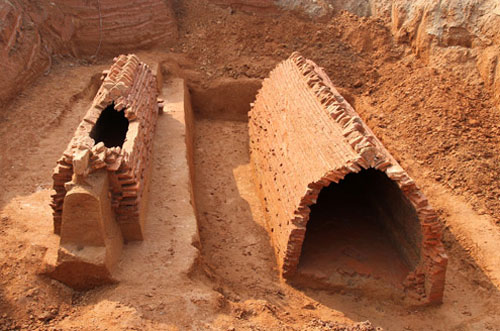Two thousand-year-old tombs were discovered in Ciputra urban area
Two graves dating from the Luc Trieu Dynasty (4th to 6th centuries) and an ancient well have just been discovered in Ciputra urban area (Hanoi) when constructing sewer pipes and making roads.
On the afternoon of April 18, at the construction area of the internal traffic road and the installation of sewer pipes of the Ciputra urban area (located close to the path of the motorbike to Thang Long bridge), 3 officials of the Institute of Archeology are on the way. excavation, drawing an ancient well and 2 ancient tombs just discovered. Continuously traveling between two excavation sites of graves and wells, associate professor, Dr. Nguyen Lan Cuong occasionally took the camera to capture the details just revealed.
Not far away, the construction unit's excavator still dug out, placing large sections of sewer pipes into the ground.
According to Dr. Cuong, in the evening of April 1, the construction unit's excavator hit the door of an ancient tomb with brick structure. After reporting to the investor and the Management Board of relics and landscapes in Hanoi, on the afternoon of April 2, the ancient tomb detection area was temporarily suspended for emergency excavation.
Excavations were conducted by the Archaeological Association and the staff of the Archaeological Research Department of the Archeology , the Institute of Archeology. With the help of the excavator, soon after, a small grave that was almost parallel was discovered. The roof of the two graves is about 2 meters deep below the ground. According to measurements, the large grave is 4.7 meters long, wide and about 2 meters high. The baby is 3.9 meters long, 1.2 meters wide; nearly a meter tall. The big grave leg is about a meter deeper than her grave.

Two graves one big one small lie parallel to each other.Photo: Nguyen Hung.
Dr. Nguyen Lan Cuong said, both graves are lined with baked bricks overlapping each other in the style of arches with pomelo bricks on the top. The difference of these two ancient tombs is the row of grave-lock bricks running all along the grave. Tiles on the inside of grave walls and ceilings are decorated with patterns. The big grave is the "money" and "cage filling" pattern, while the small grave is the "fish bone" pattern.
Pointing at a brick with an ancient character in a large tomb, the doctor said that about 40 graves in the grave were found with unknown Chinese characters. After more than 10 days of excavation, the Archaeological Institute obtained 28 artifacts in large graves and 5 artifacts in small graves. The objects are mainly pottery; 9 iron nails were rusted (believed to be the coffin for the coffin); some grains of rice, burnt rice . Both graves have no trace of coffin wood and human bones because they may have been consumed.
"Based on the grave structure, burial objects, two tombs of the Luc Trieu Dynasty date from the 4th to 6th centuries, the grave is a little earlier than the small tomb. Two graves were built according to the style. "Han is a Vietnamese man ," he said.
The doctor said that the most precious thing in this excavation is the very beautiful ceramic chicken head with the crest, eyes and tail. However, he regretted that it may have been lost immediately after the appearance of some other artifacts in the grave so the identity of the person buried in the grave cannot be determined.

Staff of the Institute of Archeology excavated at the ancient well of April 18.Photo: Nguyen Hung.
Not far from two ancient tombs, on the afternoon of April 14, Ciputra urban road construction unit continued to discover an ancient well like the wells discovered in Thang Long Citadel. The excavator had already made it more than a meter above the bottom wells still quite intact.
By the afternoon of April 18, digging more than 2 meters deep, the Institute of Archeology officials had not yet discovered all the wells. According to Dr. Cuong, it is likely that wells have the same age as two tombs. " I think that there are some relics underneath the tomb and ancient wells, possibly a village along the Red River ," Cuong said.
According to him, in foreign countries, when meeting these valuable works, people often keep the scene, preserve in place, and gather fences so that people can admire. For the well, the Hanoi Museum now plans to relocate to the Museum grounds.
" However, it is likely that after the excavation period ends with 2 graves (on April 20), the construction unit will continue to level and place the sewer, " said Dr. Nguyen Lan Cuong.
- Again discovered the ancient tomb at Ciputra
- The ancient well in Ciputra urban area is over 6 meters deep
- The con man found out about a thousand-year-old tomb
- Ancient tombs of thousands of years carry the form of 'dead boat'
- Discovered a thousand year-old grave in China
- Decode huge ancient tombs of 2000 year old stone
- Egypt discovered the tomb of the Pharaoh era writer
- The mystery of the female remains is crowning in ancient thousand-year tombs in China
- The 7,000-year-old Spanish tombstone was first 'exposed' after half a century
- Urban self-sufficiency model with 100% food and energy
- Egypt discovered a 4,400-year-old ancient tomb, full of treasures
- Egypt discovered tombs from ancient Rome
 Discovered an ancient centipede fossil 99 million years old
Discovered an ancient centipede fossil 99 million years old Discovered bat-like dinosaurs in China
Discovered bat-like dinosaurs in China Discovered a 200-year-old bronze cannon of the coast
Discovered a 200-year-old bronze cannon of the coast Discover 305 million-year-old spider fossils
Discover 305 million-year-old spider fossils